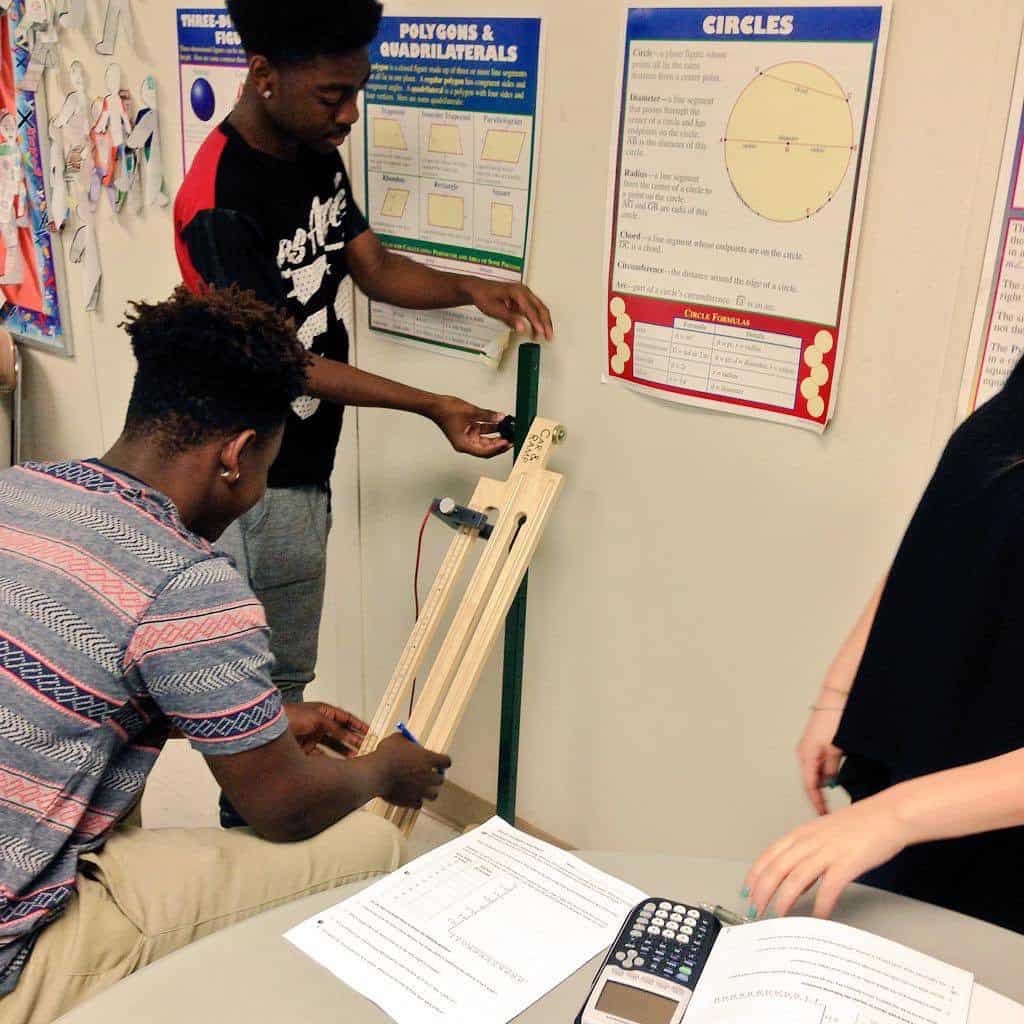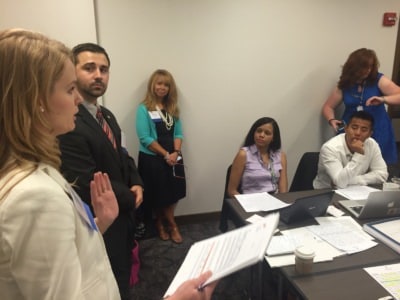The history of standards development in North Carolina
It was a little less than a week before the start of a new school year, as parents wandered the halls to their children’s soon-to-be classrooms. Out in the vinyl village (aka trailers), I welcomed my students’ parents to my class with an introduction to the new course called N.C. Math 2 Honors. As I completed my presentation of the list of topics, I shared excerpts from Jo Boaler’s book, Mathematical Mindsets, emphasizing the power of students’ mistakes as learning opportunities and the necessity of parental encouragement in fostering the learning of mathematics. To which one parent responded, “You must be talking about the ‘Common Core.’”
This statement was greeted by a few chuckles among the other parents. So, I told the story of our state’s standards. I explained how math teachers in North Carolina have gone through two major standards shifts over the past five years and how their students would be learning under the new N.C. Standard Course of Study — not Common Core — which was written by a group of district instructional specialists, university professors, and math specialists at the department of public instruction, with public feedback requested from parents and teachers (of which many from our school participated in).


Policymakers, parents, and other community stakeholders need to understand today’s math class is not like it was 20 years ago. It has evolved to address the needs of today’s careers. But in order to understand where we are, we must look at how we got here…
In 1965, the Elementary and Secondary Education Act of 1965 provided funding to states’ for public education in attempts to desegregate the nation’s public schools. Expiring every three-to-five years, this legislation established the federal government’s role in public education.
In the 1990s, the U.S. Senate voted 99 to 1 against national history standards funded by the federal government. This measure is viewed as the first attempt at overreach of the federal government into what states’ teach.
In 1995, the N.C. General Assembly passed the Basic Education Program, authorizing the State Board of Education to establish a Standard Course of Study. The following year, the state Board of Education passed the “ABCs for Public Education,” outlining the states’ standard course of study and the performance evaluation system for all K-12 schools.
In the same year, governors and CEOs create Achieve, Inc., a bipartisan organization aimed to “raise academic standards and graduation requirements, improve assessments, and strengthen accountability” in all 50 states.
In 1998, the State Board of Education adopted the Standard Course of Study.
In 2001, the No Child Left Behind Act was developed by Congress to close the achievement gap across states by increasing their testing and developing/expanding their accountability systems. It was signed by President George W. Bush in January 2002.
Under a standards revision process, the State Board of Education adopted the 2003 Standard Course of Study and Grade Level Competencies for Math and Language Arts. These competencies served as the list of topics students would be assessed on using standardized state tests, adhering to the funding guidelines outlined in NCLB. During this implementation, local districts had the choice between a traditional math course sequence or an integrated one.
As 2006-07, the National Governors Association (a think-tank organization comprised of the nation’s governors) outlined their annual initiative. The president — then Arizona Governor Janet Napolitano (now head of the University of California system) — focused on improving math and science education. The NGA developed a task force of education “heavy-hitters” — including governors, CEOs, the head of State Department of Educations, and higher education experts — to investigate the state of the U.S.’s public education system.
In 2008, the NGA’s taskforce released a report, Benchmarking for Success: Ensuring U.S. Students Receive a World-Class Education, stating, “To meet the realities of the 21st century global economy and maintain America’s competitive edge into the future, we need students who are prepared to compete…” States begin efforts to develop a standards-based education initiative.
In 2009, the NGA organized a team to write new standards for math and language arts that “provide consistent, clear understanding of what students are expected to learned, so teachers and parents know what they need to do to help them.”
Later that year, a draft of the Common Core State Standards was released to the public for comment. A team of math educators reviewed the draft and revisions were made incorporating the feedback. In June, the standards were copyrighted by the NGA and the Council of Chief State School Officers.
In July 2009, President Obama and U.S. Secretary of Education Arne Duncan announced Race to the Top competitive grants, a $4.35 billion effort to spark states’ education reform. Funded by the American Recovery and Reinvestment Act of 2009, these grants were awarded to states based on a rubric totaling 500 points (of which only 70 points were to be awarded for standards and assessments).
In June 2010, the Common Core State Standards for Math and English Language Arts standards were released.
In 2010, North Carolina was awarded $400 million in the second round of Race to the Top grants, adopting the Common Core State Standards in English language arts and mathematics.
Simultaneously, the state moved forward with an integrated high school math curriculum, a decision DPI instructional leaders and school district administrators (as a part of a math task force) had been contemplating for years. District leaders and DPI worked to write curriculum aligned to the CCSS. It is important to note that the Common Core State Standards did not mandate this integrated approach, but rather districts and DPI sought for the two to be implemented simultaneously.
North Carolina implemented the CCSS across the board for the 2012-13 school year, phasing out Algebra 1, 2, and Geometry and phasing in Math I, II, III (on a rolling yearly basis). This implementation is complete at the end of the 2014-15 school year.
In June 2014, the N.C. Board of Education developed the six-step standards-revision process (GCS-F-012) to occur every five years by the Department of Public Instruction. DPI began the revision process for the Common Core State Standards.
In 2014, the N.C. General Assembly appointed the Academic Standards Review Commission, and tasked it with evaluating the implementation of the Common Core State Standards in North Carolina classrooms.
In 2015, the Every Student Succeeds Act became law, replacing NCLB. ESSA bars the U.S. Department of Education from compelling states to adopt any specific standard course of study, eliminating the amount of testing under NCLB and placing the accountability models with the states.
At the same time, the N.C. Academic Standards Review Commission adjourned, supporting a rewrite of the state’s high school math standards, but opposing recommendations of returning to the old Algebra 1, 2, Geometry sequence, and replacing lower grades standards with Minnesota State Standards.
During the 2015-16 school year, DPI and a collection of district instructional leaders, classroom teachers, and university faculty rewrote and reorganized the secondary math standards, renaming the high school math sequence N.C. Math 1, 2, 3. Educators, parents, and other community stakeholders were asked to provide input on the new state standards.
High school math teachers began implementing the new NC Standard Course of Study with a new integrated Math course sequence for the 2016-17 school year. DPI and districts provided course resources and webinars to aid the implementation of the new standards.
Over the past half-century, our state’s schools have changed for good reason. In the past decade, our high school math classrooms have changed even more. With three sets of standards since 2003, two of which were implemented in the last five years, teachers need time to adjust. Our students need teachers who can consistently teach a course without fear of it changing the following year.




As we’ve seen in the progression since 1965, the educational landscape is constantly changing to benefit all of our students. These latest changes, though controversial, aim to prepare our students for a technology-rich and information-saturated world, both in the workplace and higher education. These secondary math standards are no longer the Common Core State Standards.
They are stronger.
This is where we are and how we got here. I hope through this series, I can show you the evolution of today’s math classes from the past to the present and into the future, and the positive impact on our students statewide.



